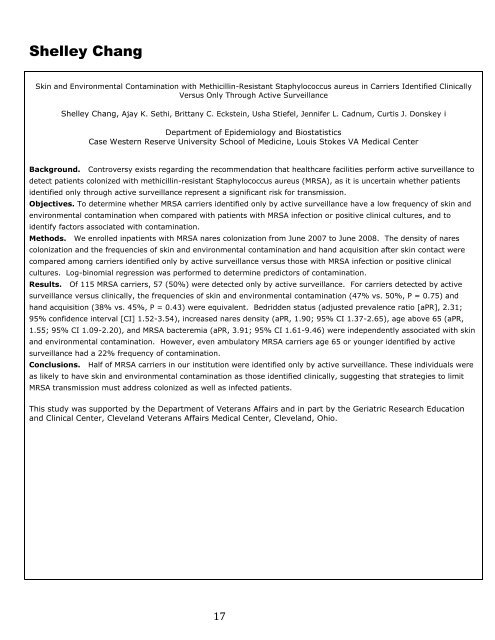student research day - Case Western Reserve University School of ...
student research day - Case Western Reserve University School of ...
student research day - Case Western Reserve University School of ...
You also want an ePaper? Increase the reach of your titles
YUMPU automatically turns print PDFs into web optimized ePapers that Google loves.
Shelley Chang<br />
Skin and Environmental Contamination with Methicillin-Resistant Staphylococcus aureus in Carriers Identified Clinically<br />
Versus Only Through Active Surveillance<br />
Shelley Chang, Ajay K. Sethi, Brittany C. Eckstein, Usha Stiefel, Jennifer L. Cadnum, Curtis J. Donskey i<br />
Department <strong>of</strong> Epidemiology and Biostatistics<br />
<strong>Case</strong> <strong>Western</strong> <strong>Reserve</strong> <strong>University</strong> <strong>School</strong> <strong>of</strong> Medicine, Louis Stokes VA Medical Center<br />
Background. Controversy exists regarding the recommendation that healthcare facilities perform active surveillance to<br />
detect patients colonized with methicillin-resistant Staphylococcus aureus (MRSA), as it is uncertain whether patients<br />
identified only through active surveillance represent a significant risk for transmission.<br />
Objectives. To determine whether MRSA carriers identified only by active surveillance have a low frequency <strong>of</strong> skin and<br />
environmental contamination when compared with patients with MRSA infection or positive clinical cultures, and to<br />
identify factors associated with contamination.<br />
Methods. We enrolled inpatients with MRSA nares colonization from June 2007 to June 2008. The density <strong>of</strong> nares<br />
colonization and the frequencies <strong>of</strong> skin and environmental contamination and hand acquisition after skin contact were<br />
compared among carriers identified only by active surveillance versus those with MRSA infection or positive clinical<br />
cultures. Log-binomial regression was performed to determine predictors <strong>of</strong> contamination.<br />
Results. Of 115 MRSA carriers, 57 (50%) were detected only by active surveillance. For carriers detected by active<br />
surveillance versus clinically, the frequencies <strong>of</strong> skin and environmental contamination (47% vs. 50%, P = 0.75) and<br />
hand acquisition (38% vs. 45%, P = 0.43) were equivalent. Bedridden status (adjusted prevalence ratio [aPR], 2.31;<br />
95% confidence interval [CI] 1.52-3.54), increased nares density (aPR, 1.90; 95% CI 1.37-2.65), age above 65 (aPR,<br />
1.55; 95% CI 1.09-2.20), and MRSA bacteremia (aPR, 3.91; 95% CI 1.61-9.46) were independently associated with skin<br />
and environmental contamination. However, even ambulatory MRSA carriers age 65 or younger identified by active<br />
surveillance had a 22% frequency <strong>of</strong> contamination.<br />
Conclusions. Half <strong>of</strong> MRSA carriers in our institution were identified only by active surveillance. These individuals were<br />
as likely to have skin and environmental contamination as those identified clinically, suggesting that strategies to limit<br />
MRSA transmission must address colonized as well as infected patients.<br />
This study was supported by the Department <strong>of</strong> Veterans Affairs and in part by the Geriatric Research Education<br />
and Clinical Center, Cleveland Veterans Affairs Medical Center, Cleveland, Ohio.<br />
17
















